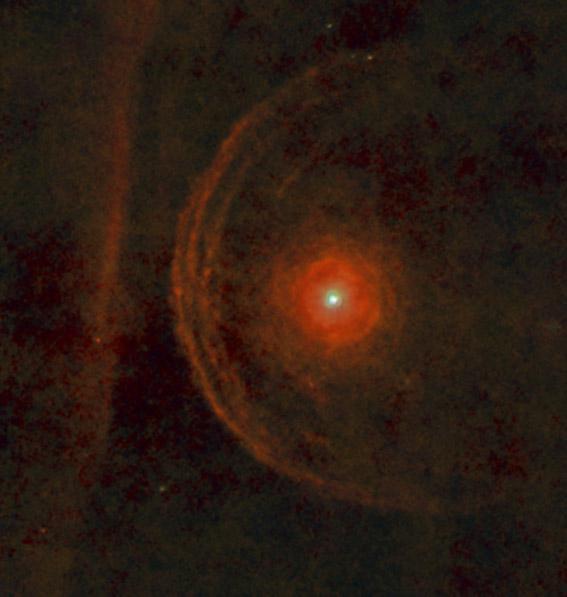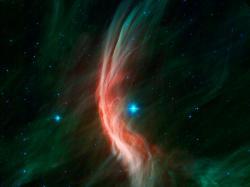Last night I was outside doing a little stargazing, and I showed the star Betelgeuse to my daughter and her friend. It’s easy to see, being one of the brightest stars in the sky, and such a baleful orange-red it stands out as one of the few stars with obvious color.
Through my small telescope it was intense, its 600+ light year distance deceptive due to the star’s luminosity—it’s intrinsically over 100,000 times brighter than the Sun. That’s because it’s a red supergiant, a massive star nearing the end of its life. In the next million years or less it will explode, going supernova, and for a few weeks may get as bright as the full Moon in the night sky.
But it has an appointment to meet long before then. Looking through my telescope with my eyes there was no hint of this, but when you see this picture taken by the European Space Agency’s Herschel telescope, things become far more clear:

Image credit: ESA/Herschel/PACS/L. Decin et al.
Spooky, isn’t it? Herschel detects infrared light, far outside what the human eye can detect. In those wavelengths, vast shells of dust surrounding Betelgeuse become visible. All stars emit a wind of subatomic particles—we call the Sun’s the solar wind. Red supergiants do as well, but their outer atmospheres are far cooler than our Sun’s, so the chemistry is different. More complex molecules can form, including what we call dust. This dust is warmed by the star and glows in the far infrared, where Herschel can spot it.
You can see the dust forms thin shells around the star. That indicates the wind isn’t constant. Most likely Betelgeuse expels dust in periodic episodes, rapid spasms of wind that blow out more dust than usual. Think of it as the star coughing—it’s dusty there, after all.
You might expect the dust to form a sphere centered on Betelgeuse, but you can see the star is well off-center to the left. That’s because Betelgeuse is a star in motion! It’s moving through space at about 30 kilometers per second (18 miles per second, or about 65,000 miles per hour). Space isn’t really a vacuum, it’s only mostly a vacuum: There is material between the stars, a thin soup of dust and gas. The dust slows as it expands into this interstellar matter, but Betelgeuse just rams right through it, eventually becoming noticeably off-center.

Image credit: NASA/JPL-Caltech
And note the thin straight filament of material on the left. That is most likely a denser region of interstellar matter, and Betelgeuse is headed right into it. Given the distances involved and the star’s speed, the expanding shells of dust will slam into the wall in about 5000 years, and the star itself will make contact in about 18,000 years. When the dust collides it will heat up and brighten; it will still be invisible to the naked eye, but in telescopes like Herschel (or whatever we’ll be using in 7000 AD) it will create gorgeous filaments and streamers. We’ve seen this before, like with the star Zeta Ophiuchi, seen inset here.
Betelegeuse remains high in the northern hemisphere skies for a couple of more months, and is worth your time to take a look. When you see it, remember two things: There is always more going on in the Universe than meets the eye, and that this great, bright star will one day go out in a blaze of glory as a spectacular supernova.
All good things must come to an end because, of course, all we are is dust in the wind. Dude.